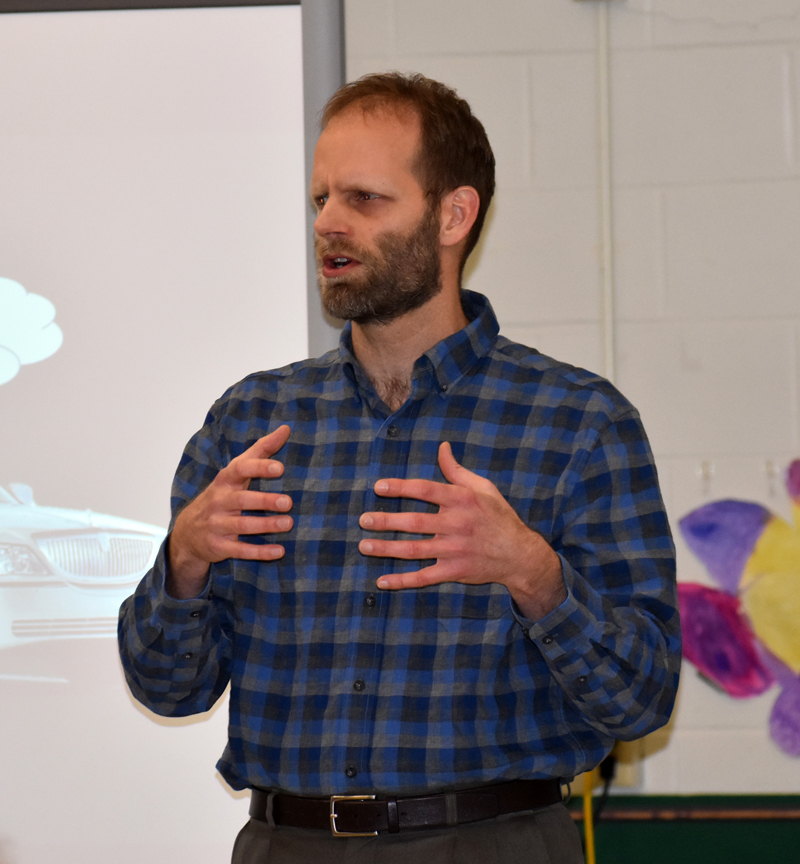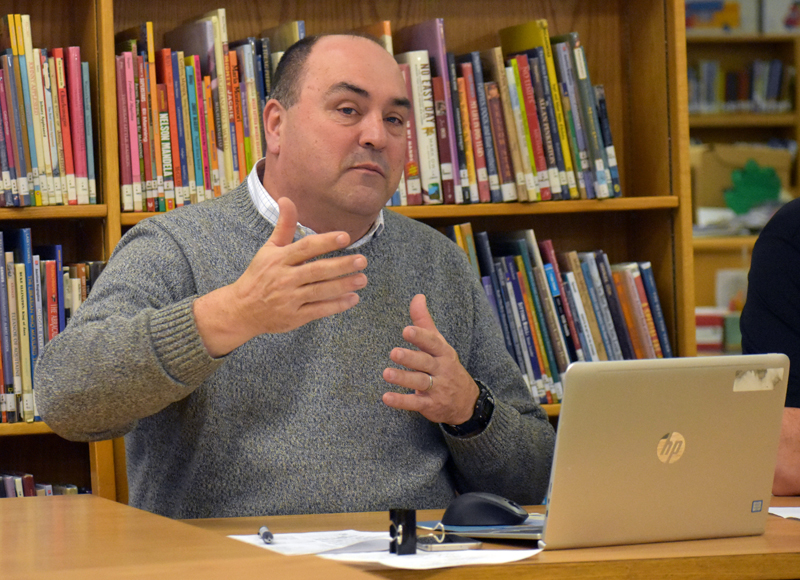
Garret Martin, of Newcastle, presents the results of AOS 93’s survey about Lincoln Academy during a meeting at Great Salt Bay Community School in Damariscotta on Thursday, March 15. (Alexander Violo photo)
Data from AOS 93’s survey about Lincoln Academy, conducted from November-December 2017, were presented during a special meeting at Great Salt Bay Community School in Damariscotta on Thursday, March 15.
With responses from 406 people, the survey results show both areas where respondents feel the Newcastle high school excels and areas where they see room for improvement.
Opening the meeting, AOS 93 interim Superintendent Jim Hodgkin explained why the school district decided to conduct a survey.
“Last summer, questions and concerns were raised to the AOS board by citizens in respect to Lincoln Academy,” Hodgkin said. “The AOS board felt secondary education students in the district were the responsibility of the board … and there was enough feedback, both positive and negative, to follow up.”
“The comments were very impressive and showed a great deal of thought and insight,” Hodgkin said.
Hodgkin said that from his year as interim superintendent and his previous experience as an administrator, he believes a community wants to feel good about where it sends its children to school.
“My experience is, people want to feel very good about their schools. Our goal, and one of the things I tried to share, is this needs to be about how we foster and push for a close relationship with Lincoln,” Hodgkin said.
Hodgkin then introduced Garrett Martin, of Newcastle, a volunteer who presented the survey results.
Hodgkin said Martin did not participate in the development of the survey, but AOS board members requested his assistance to analyze the results based on his academic and professional experience in quantitative analysis.
“We have a gift from the community who volunteered to assess the data, put it all together, make some sense of it, and present it in a digestible form for the community,” Hodgkin said.
Martin holds a master’s degree in public affairs from Princeton University and is the executive director of the Maine Center for Economic Policy. He coaches cross-country at LA.
Martin began his presentation with an overview of the survey. Of the total responses, 387 came from the seven towns in the AOS and 19 from other towns, some of which send students to LA, including Alna, Edgecomb, Freeport, Knox County towns, and other countries.
Martin, in a phone interview after the meeting, said he feels the quantity of responses to the survey was a very strong number.
“To put it in some context, when pollsters do polling around various issues and elections in general for the whole state, 800-900 responses is viewed as a robust enough number to give them perspective. For a part of Lincoln County to generate 406 respondents is a very solid number,” Martin said.
Martin said that from a statistical standpoint, the number of responses provided a good amount of data to work with.
“Forty or less respondents would have been outside the realm of being able to do anything meaningful with. Anything north of 200 to 250 is a pretty good number,” Martin said.
Martin said 26 percent of respondents reside in Newcastle, 18 percent in Bristol, 17 percent in Damariscotta, 12 percent in Bremen, 11 percent in Nobleboro, 6 percent in Jefferson, 5 percent in South Bristol, and 5 percent outside the AOS.
Sixty-four percent of respondents identified themselves as taxpayers, 33 percent as a parent or guardian of a current student, 31 percent as a parent or guardian of a former student, 23 percent as alumni, 8 percent as current employees, and 3 percent as students.
Martin, after the meeting, said the sheer quantity of responses to the survey indicate the import towns in the county place on LA.
“It speaks to the way that people in this community really support Lincoln and value it as an institution, while giving value to the survey itself,” Martin said.
“There are very positive things going on at Lincoln that people recognize and appreciate. The teaching faculty and co-curricular activities really stood out as parts of the school the community values and feels satisfied with,” Martin said.
Regarding areas of concern, Martin said he believes the survey provides LA an important opportunity to reflect and work toward maximizing what the school has to offer to the community.
“I think as a community we have an opportunity to continue to engage in a meaningful dialogue and support continuous improvements, not just at Lincoln Academy, but in education throughout the community,” Martin said.
Survey results indicate respondents had a high level of satisfaction with LA’s co-curricular activities, with 82 percent satisfied or very satisfied; the length of the school year, 80 percent; and faculty, 79 percent; as well as academic rigor and curriculum and course offerings.
Current students had higher net satisfaction levels for co-curricular activities, 100 percent; academic rigor, 92 percent; and length of the school year, 92 percent.
Employees’ highest levels of satisfaction were with co-curricular activities, 100 percent; teaching faculty, 90 percent; and curriculum and course offerings, 83 percent.
The areas where respondents indicated their lowest levels of satisfaction were the school’s responsiveness to public input, 37 percent net satisfaction; responsiveness of the administration, 43 percent; and guidance department, 44 percent. Respondents also indicated some dissatisfaction with the school’s Eagle Term and laptop policy.
Current students have the highest levels of dissatisfaction with LA’s receptiveness to public input, 75 percent unsatisfied; responsiveness of the administration, 58 percent; and Eagle Term, 67 percent.
Martin said that with the exception of Eagle Term, current employees have higher levels of satisfaction on the bottom five aspects compared to all respondents.
Martin said academic rigor (87 percent) and school location (71 percent) are the most important factors in deciding where students attend high school, according to the survey data.
Alumni and parents of future students differed on the importance of certain factors. A lower percentage of alumni, 76 percent, identified academic rigor as one of the most important factors, while a higher percentage cited family history, 30 percent, and vocational choices, 20 percent, as top factors in deciding on a high school.
Martin said parents of future students identified academic rigor, 91 percent; attendance with friends, 48 percent; and busing, 18 percent, as the top three factors for their demographic.
Martin said a higher percentage of residents from Jefferson (35 percent), Bristol (22 percent), and Nobleboro (20 percent) identified busing as an important factor.
Operational transparency and school finances received the lowest effectiveness ratings from respondents, with 47 percent and 38 percent indicating Lincoln Academy was not effective in these areas, respectively.
Another finding indicates that the availability of transportation could impact future decisions about where students attend high school.
According to the presentation, 31 percent of all respondents and 47 percent of parents of future students would consider other options if transportation was provided.

AOS 93 interim Superintendent Jim Hodgkin proposes ways the school district could share the results of its survey about Lincoln Academy with the LA Board of Trustees and the public. (Alexander Violo photo)
The top four choices for alternative school options were Camden Hills Regional High School, 22 responses; Medomak Valley High School, 21; North Yarmouth Academy, 15; and Boothbay Region High School, 12.
The survey results also include 89 pages of comments on a wide range of issues, including Eagle Term, the school’s boarding program, and its guidance department.
The comments are responses to specific questions, including about satisfaction with aspects of the school and how effectively LA addresses various issues.
“The guidance comments weren’t uniform in their concern, but were uniform in expressing frustration,” Martin said.
Martin also spoke on the transition from K-8 schools to Lincoln as a focus of many comments.
“It could be an issue of communication from Lincoln or other needs on the K-8 side of the ledger,” Martin said.
In a memo to the AOS board, Martin said the “real value” of the survey would come if the LA board is “brought in to take steps to address concerns raised in the survey.”
Martin said he believes the AOS accomplished what it set out to do with the survey.
“I think the AOS has done a good job, giving the public an opportunity to express their views on Lincoln Academy. They did what they were trying to do – assess experiences with Lincoln Academy,” Martin said.
Martin said he has not been asked to present to the LA board, but would be happy to do so.
“I’m happy to talk to anyone who wants to look at the quantitative side of the results,” Martin said.
In a phone interview after the meeting, Hodgkin said he believes the meeting was a positive experience for participants from the AOS, the LA Board of Trustees, and the public.
“I do think it went well. If nothing else came out of the survey, what we expected was proven to be true. Students’ day-to-day interactions at the school are positive, students are receiving a positive educational experience, and most of the concerns deal with administration and finances,” Hodgkin said.
LA Board of Trustees President Christine Wajer emailed a statement to The Lincoln County News on the behalf of the board.
“The completion and publication of the AOS Survey has brought to the Board of Lincoln Academy’s attention both the significant strengths that our school possesses and some significant needs, especially the need to clarify and reinforce our role as a community institution and to address the public’s desire for greater transparency and more open communication with the school,” Wajer said.
Wajer said the trustees have heard the community’s feedback and will work with soon-to-be interim Head of School Nancy Starmer to arrange times to meet with faculty, staff, parents, and community members over the next few months.
“As a board, we have been working hard over the last year to determine how best to address community concerns and better define our mission and role as a town academy,” Wajer said. “We feel that we’ve made progress on both of these fronts, and with new leadership coming into the school and some critical data now available to us, we are in a position to communicate more knowledgeably and openly about these issues with our parents, our sending schools, and the towns and local school boards we serve.”
An 11-page memo from Martin and a video of the meeting are available at aos93.org.
The district intends to post the 89 pages of comments on the website after it redacts comments about specific school employees. Hodgkin said the district previously posted the comments, but took them down at Wajer’s request.
Note: See related story, “AOS 93 Board Plans for Release of Survey Data.”



